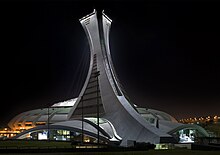Architecture of Montreal

The architecture of Montreal, Quebec, Canada is characterized by the juxtaposition of the old and the new and a wide variety of architectural styles, the legacy of two successive colonizations by the French, the British, and the close presence of modern architecture to the south. Much like Quebec City, the city of Montreal had fortifications, but they were destroyed between 1804 and 1817.
For over a century and a half, Montreal was the industrial and financial centre of Canada. The variety of buildings included factories,
From the Art Deco period, Montreal offers a handful of notable examples: Ernest Cormier's Université de Montréal main building located on the northern side of Mount Royal and the Aldred Building at Place d'Armes, an historic square in Old Montreal.
In fact, Place d'Armes, shown in panorama below, is surrounded by buildings representing several major periods in Montreal architecture: the
Church architecture
Founded as a
Following the British victory in the
Skyscrapers

Skyscraper construction in Montreal has swung between periods of intense activity and prolonged lulls. A two-year period from 1962 to 1964 saw the completion of four of Montreal's ten tallest buildings:
Montreal places height-limits on skyscrapers so that they do not exceed 200m in height nor the summit of
The Tour de Montréal, incorporated into the north base of Montreal's Olympic Stadium is the tallest inclined tower in the world, at 175 m (574 ft).[6]
Expo 67

Pavilions designed for the 1967 International and Universal Exposition, popularly known as
Montreal Metro
In terms of modern architecture, the Montreal Metro is filled with a profusion of public art by some of the biggest names in Quebec culture. In addition, the design and ornamentation of each station in the Metro system is unique, much like the Stockholm Metro and the Moscow Metro.
Other notable structures

Other significant works of modern architecture in Montreal include the
Montreal architects
In 2006, the city was recognized by the international design community as a UNESCO City of Design, one of the three world design capitals.[11]
Heritage conservation
The
See also
- Architecture of Canada
- Architecture of Quebec
- Arcop
- Culture of Montreal
- Golden Square Mile
- List of National Historic Sites of Canada in Montreal
- List of old Montreal buildings
- List of Quebec architects
- Percy Erskine Nobbs
- Underground City, Montreal
References
- ^ Szasz, Colin (2000-12-11). "Montreal's Original Skyscraper: The Aldred Building". McGill School of Architecture. Archived from the original on 8 March 2008. Retrieved 2008-03-03.
- ^ "La Place d'Armes". Old Montreal Web site. Retrieved 2008-03-20.
- ^ Twain, Mark (1881-12-10). "MARK TWAIN IN MONTREAL". New York Times. Retrieved 2008-02-02.
- ^ Heffez, Alanah (2008-03-06). "Skyline Planning". Spacing Montreal. Archived from the original on 2009-05-24. Retrieved 2008-04-25.
- ^ "Plan d'urbanisme". Ville de Montréal. Retrieved 9 January 2024.
- ^ "Tour de Montréal". Emporis. Retrieved 2 April 2020.[dead link]
- ^ ICI.Radio-Canada.ca, Zone Art de vivre-. "Le Casino de Montréal souffle 25 bougies". Radio-Canada.ca (in Canadian French). Retrieved 2 April 2020.
- ^ "Place Bonaventure". The Canadian Encyclopedia. Retrieved August 25, 2019.
- ^ "Montréal's Architects: David et Boulva". Images Montréal. Archived from the original on 30 April 2008. Retrieved 2008-03-21.
- ^ "2007 BOMA Canada National Awards Finalists" (PDF). Building Owners and Managers Association of Canada. Archived from the original (PDF) on 2009-03-04. Retrieved 2008-03-21.
- ^ "Cities appointed to the Creative Cities Network". UNESCO. Archived from the original on 2008-01-26. Retrieved 2007-11-22.
- ^ "Le Conseil du patrimoine de Montréal". City of Montreal. Retrieved 2009-03-22.
- ^ Gravenor, Kristian (October 23, 2003). "The museum that is Montreal", Montreal Mirror 19 (19). Retrieved on 2009-02-11.
- ^ "Phyllis Lambert". Canadian Urban Institute. Archived from the original on 2011-07-06. Retrieved 2009-03-22.
- ^ "New think tank will act as conscience for mayor". Montreal Gazette. Canwest. October 15, 2009. Retrieved 21 November 2009. [dead link]
External links
- Architecture of Montreal, Archiseek
- Québec Religious Heritage Foundation
- Héritage Montréal
- Kollectif::Information::Architecture::Montréal
- Architecture of Old Montreal
- Images Montreal (IMTL.org) an historical encyclopaedia and a guide to the modern architecture of Montreal
- Lam, Elsa (October 2003). "Quel Fromage! A survey of the kitsch architecture in Montreal". Canadian Architect. Retrieved 2009-02-06.
- Canadian Centre for Architecture


